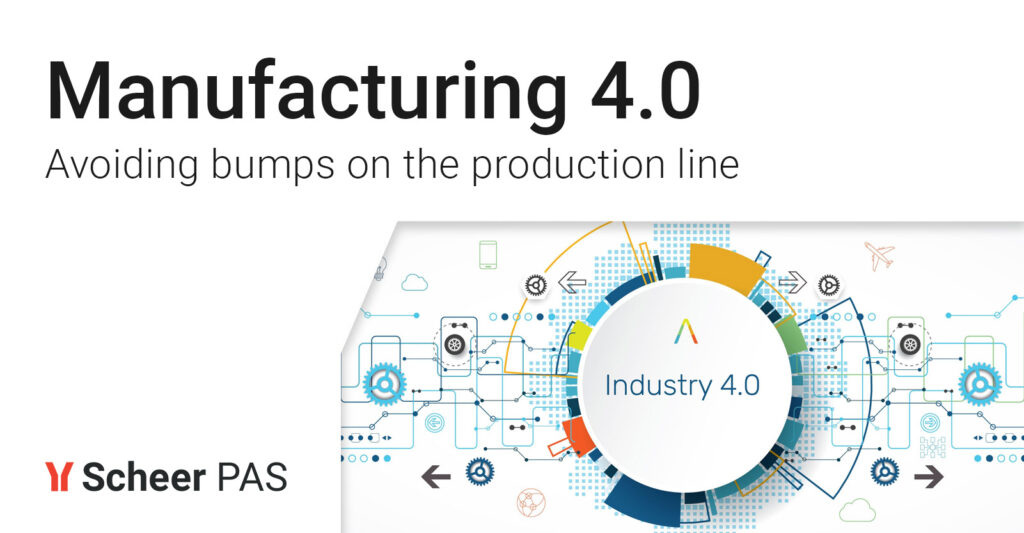Avoiding bumps on the Manufacturing 4.0 production line

Manufacturing ideas to overcome the last couple of years was (and for some it still is) hard enough but manufacturing products is a whole different sport. Following the trends in the IT industry, a new term could come to your attention just because of how vague it is. “Industry 4.0” or to be more precise “Manufacturing 4.0” sounds immensely techy, but it isn’t. To put it in three simple terms, “Manufacturing 4.0” besides everything else means digitization, digitization and some more digitization just for a good measure.
But let’s slow down a bit. There are 4 major hurdles for any company that is even considering digitization of their manufacturing processes. In no particular order, those are financial investment, the lack of framework for the transition, cybersecurity, and technical support. Manufacturing companies are well aware that the process of digitization is unavoidable to keep them afloat, especially in the last couple of years but these scary things are preventing them from even trying.
1. Roadmap

As the requirement of a roadmap for digitization is a necessity for anyone dealing with manufacturing, having a well-planned roadmap that considers vision, budget and timescale is already a first step into being too late for the party when the competition is already ahead. Defining such a roadmap is often difficult without an outside company doing the consulting so any sane manufacturer would appreciate a “one-stop-shop” solution for this. If there was just a company that could do it all…but we’ll get to that later.
2. Security

Who knows a precise recipe for Coca-Cola, Nutella, Big Mac? That’s right, going through digitization process has to involve some automation that relies on data but the more of your precious data you take to the cloud, the more Pepsis, Nutella’s and Whoppers there will be. In other words, digitization is a necessity but can lead to not running ahead of your competition but creating more of it. Then why shouldn’t a manufacturer have everything automated and more efficient with the central data point running the process mining next to their desk? Of course, On-Site implementations can provide you with this option.
3. Support

Now hypothetically, let’s say that you’ve jumped over the first two hurdles. You’ve got the vision, you’ve got the equipment, now you need to do something with it not just to save costs in the future but keep your job as the CIO. Low-Code development by your own employees will give you a head start but your manufacturing company has such specific needs that you need help and support of professional software developers (which you do not have in your company). Handout from Low-Code to Pro-Code in order to customize the software which will help you in your digitization quest is a must, especially when dealing with robust platforms that give you so many options that it scares you to try dwelling into them. So then, write an e-mail and you’ve already taken a huge step.
4. Finances

But if you take a step back while reading the CFO’s mail in which they are demanding a financial report of the progress of digitization which should in long-term help the company financially, you keep thinking about the cost of everything. You’re getting invoices from one company that has done the consulting and created some roadmaps, the other company demands the payments ahead of securing your company’s secret sauce, you have the third company on the phone walking you through some code and reminding you of your debt towards them, and all you can think of is “Is this all worth it?” Such projects demand solid investments and the lack of starting funds or ROI assessments to even try. All this can keep your business running today or tomorrow but what about the day after tomorrow?
To recap
In order to get your manufacturing business and turn its marketing slogan into something similar to “We too belong to 4.0”, you need:
- Someone to create your digitization roadmap which includes every bit of information from your side, and good advice from certain someone.
- You need to have secure access to your data from anywhere but keep it “in the family” of your own location.
- A person who can help you to steer the boat when the waters get muddy and require your attention.
- A satisfied CFO who got acquainted with the costs of going through such process and the potential future benefits of it.
So in an ideal world, your manufacturing company would have to have:
– Every part of its business process digitized and mined for further efficiency
– Flexible framework adaptable to any change (both from inside and outside)
– A simple toolset to implement, execute and monitor the necessary changes
– Someone who could help when things go wrong
Well, you do not live in an ideal world and your product isn’t ideal, but your business could take a first step towards becoming ideally optimized, resilient and adaptable. That 4.0 could be much closer and you can manufacture your plan for digitization, secure it, and have someone help you out through the whole process. Just make sure not to lean on monolithic systems because that can cost you up to $500 million.



